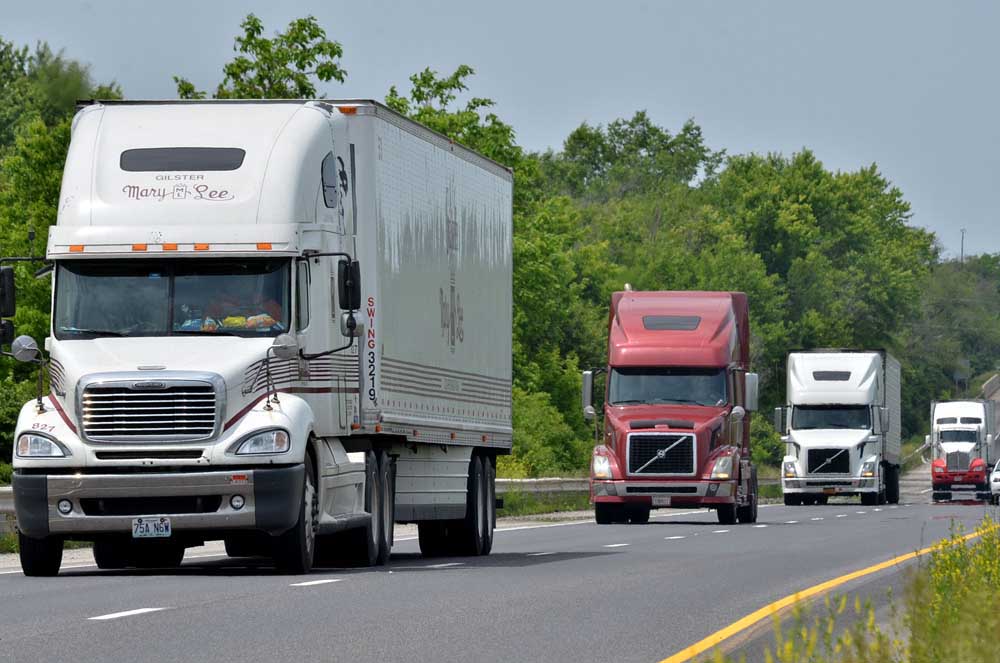Rule to slow down semi-trucks languishes
Published 1:30 pm Wednesday, May 25, 2016

- Four years ago, transportation officials were drawing up a rule to require heavy trucks be outfitted with technology that prevents them from going faster than 65 mph. But the rule sill hasn't materialized, frustrating a trucking group and the father of a Georgia man who was killed when he was rear-ended by a speeding truck. Here a series of trucks heads eastbound on I-70 near the 13th street overpass in Terre Haute.
WASHINGTON – Technology slowing down heavy trucks could mean fewer deaths on the nation’s roadways, federal officials say.
But a decade after the idea was proposed – and tens of thousands of highway deaths later – it remains mired in the federal bureaucracy.
Trending
Lack of action has frustrated the American Trucking Association, which proposed in 2006 that heavy trucks be required to install devices to keep them from going faster than 65 mph.
It has also angered the father of a 22-year old college student from Georgia who was killed when he was rear-ended by a speeding truck.
“It’s beyond frustrating,” said Stephen Owings, who started a road safety advocacy group, Road Safe America, after the death of his son, Cullum, in 2002.
Sen. Johnny Isakson, R-Georgia, has also grown impatient. The Senate last week added an amendment to a transportation funding bill, pushed by Isakson, designed to put heat on the National Highway Traffic Safety Administration to enact the rule.
In a statement Tuesday, Isakson noted the process has gone through “years of delays.”
“The time has come for this safety measure to be officially put into place before another life is lost to an accident caused by a runaway truck,” he said.
Trending
Between 2002, when the trucking association and Owings’ group proposed the idea, and 2014, the last year for which data are available, crashes involving heavy trucks claimed 36,769 lives.
It’s impossible to tell how many of those deaths could have been prevented had the speed limiting devices been mandated, said Rob Abbott, vice president of safety policy for the trucking group.
“But, intuitively, those that weren’t avoided would have been made less severe,” he said.
When the highway agency finally took up the idea in March 2011, it estimated that a key piece of the review process, a financial analysis by the Office of Management and Budget, would be done by that December. The agency was expected to be in position to enact the rule in 2012.
However, the proposal wasn’t sent for analysis until last May – four years behind schedule. More than a year later, the budget office is still studying it.
The budget office analyzes proposed rules for lawfulness, adherence to the president’s policies and possible conflicts with other rules.
The delay could be explained by a mandate on the office to analyze Congress’ proposals before those suggested by outside groups, Abbott said.
But he, Isakson and the Owner-Operator Independent Drivers Association, which opposes the idea, say they haven’t been told what’s holding things up.
A statement by the highway agency said only that it “intends to issue a proposed rule when inter-agency review is completed.”
The budget office did not return a press inquiry this week.
According to a 2003 auditor’s report, details about how the office conducts reviews are murky. One government official described the process as a “‘black box’ into which agencies submit rules that later come out intact, changed, withdrawn, or returned,” according to the report.
“We’ve been trying to nudge that thing out of there for a year now,” Owings said.
Owings believes speed was a factor in his son’s death.
Cullum Owings had been home in Atlanta from Washington and Lee University in Virginia for Thanksgiving break in 2002.
He was stopped in holiday traffic on his way back to school when he was rear-ended. His father said the truck had been going faster than 70 mph.
The owner-operator group isn’t sorry for the delay. It argues the proposal will actually make the roads more dangerous.
Truck drivers with the devices won’t be able to accelerate when passing or to avoid dangerous situations, the group says.
In areas where speed limits are higher than 65 mph, cars will get stuck behind the trucks. Those trying to pass trucks on two-lane roads could encounter oncoming traffic.
Limiting truck speeds will also keep drivers behind the wheel longer, making it more likely that they’ll get tired, the group has told the highway agency.
The owner-operator group’s spokeswoman, Norita Taylor, said the larger trucking association is simply trying to push its smaller competitors out of business.
Individual owner-operators have also complained to the agency that having to go slower will cost drivers money because they get paid by the mile.
If the agency wanted to slow truckers down, owner-operators said, it would require drivers be paid hourly wages.
Owings agrees that drivers should be paid by the hour, but limiting how fast trucks can go will help, as well, he said.
“It’s frustrating me, we have all these regulatory burdens that are keeping us from doing things that are just common-sense,” he said.
Kery Murakami is the Washington, D.C. reporter for CNHI’s newspapers and websites. Reach him at kmurakami@cnhi.com


